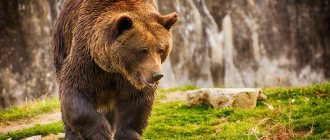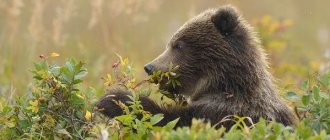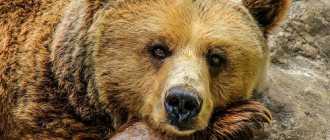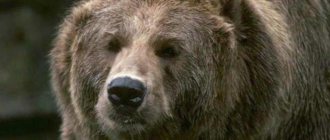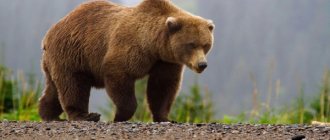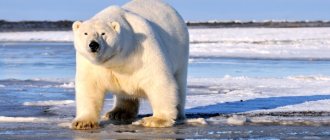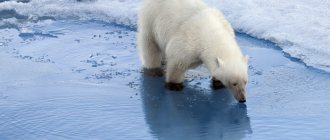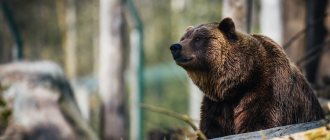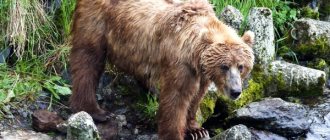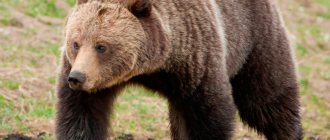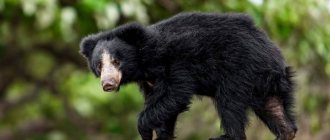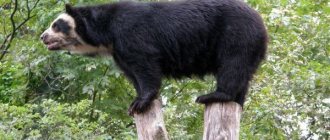Bears belong to the genus of mammals from the order of predators. They appeared on our planet approximately 4–6 million years ago in what is now France. The youngest species of bear is the polar bear. Everyone has always known that the bear is the largest predator in the whole world. In nature, he cannot make enemies. Its speed when running after prey can be about fifty km/h, and after a hearty lunch it can feast on sweet berries. But the bear does not always manage to eat enough, so he tends to go from one extreme to another.
Description, structure, what it looks like
The structure of the skeleton and the location of the organs of a bear
The bear is the largest predator on the planet, surpassing even the lion and tiger in size. The beast has been walking the Earth for almost 5 million years, and during this time it has managed to gain a foothold in the status of one of the most dangerous. The sizes of different types are in the range of 1.2 to 3 meters, and the weight varies from 40 kg to a ton. Bears have a massive body, a thick neck and a large round head.
The predator is endowed with powerful jaws that help chew any food.
On the sides of the small front teeth are large fangs. The animal moves on thick bent legs. Interesting fact : due to the fact that the bear's paws are slightly curved to the side, he has a clubfoot.
But this does not stop him from running fast, reaching speeds of up to 50 km/h. The bear not only navigates well in forest areas, but also swims well. Any species is capable of traveling long distances through water. And the white one even has membranes on its paws, allowing it to swim even faster. The animal climbs trees perfectly, climbing them in just a few seconds. All this makes him an excellent pursuer, who in any conditions can catch up with prey, no matter where it is hiding.
Bears' hearing and vision are poorly developed, but the same cannot be said about their sense of smell. The animal is able to smell even a faint odor and determine the direction from which it comes. Thanks to this, it is perfectly oriented in space.
Scheme of a bear's den
The color of a bear's fur depends on its species. It can be black, brown, white. Skin color is also determined by this parameter. Whites have black skin under their fur. This helps to receive more heat from the sun's rays in cold climates. In brown ones it is gray. Sometimes bears develop a rare disease, due to which hair on the body is almost completely absent. The most famous in this regard is the female Dolores, who lives at the Leipzig Zoo.
Description of the bear
He has a short and thick body, the same neck, and an elongated muzzle. The predator has small eyes and ears. Despite this, he has excellent eyesight and excellent hearing.
The paws have 5 toes with long, very powerful claws. It is not for nothing that they call it clubfoot, because the animal walks by stepping completely on its entire foot. This makes his gait seem clumsy. In fact, without being particularly graceful, bears can move quite quickly. They are very hardy, so they are able to cover long distances without rest.
All bears have a tail. It is usually very short and inconspicuous. Only the giant panda has a large tail.
Animals swim well. The polar bear has webbed feet. Thanks to this, he can stay in the water for a long time, covering distances of 30 km or more without rest.
Lifestyle
Most bears live in forests.
All types of bears lead a sedentary lifestyle. The exception is the white one, which can periodically migrate and occupy new territories. Mother bears live with their cubs while they become accustomed to the world around them. Adult males stay solitary and occupy a specific location. If several individuals live in one forest, then each one respects the established boundaries, hunting only on their own lands.
Interesting fact : bears mark their territory by leaving marks on trees using their claws. The animal also marks its boundaries with the help of smell.
Throughout the day, the bear walks around its territory and looks for food. Having eaten enough, the predator returns to the den - a large hole dug in the ground. There he sleeps and rests. Closer to winter, the animal begins to eat food in large quantities in order to gain weight. With the onset of cold weather, it goes into hibernation, and its body functions at the expense of fat, the mass of which can reach up to 200 kg. This turns out to be enough to remain in a state of suspended animation for several months without harm to health.
Why connecting rod?
Before hibernating for the winter, the bear must gain the required amount of fat reserves. If it is not enough, the animal has to wander further in search of food. This is where the name comes from - connecting rod.
Moving during the cold season, the bear is doomed to death from frost, hunger or a hunter's gun. However, in winter you can find not only connecting rods. Often a bear's sleep can simply be disturbed by people. Then this well-fed animal is forced to look for a new shelter in order to plunge into hibernation again.
Food, what does a bear eat?
Some bears love berries.
The bear adapts perfectly to its surrounding conditions and is able to eat almost any food. They can eat both berries and fruits of trees, and various animals: rabbits, moose, deer and other herbivores can end up in the animal’s stomach. Individuals living near bodies of water can enter them and fish. The bear has an excellent reaction, which allows it to grab any fast creature, even under water.
Interesting: Domestic animals - who they are, types, classification, history of domestication, interesting facts, photos and videos
The animal is especially greedy for sweets. Because of this, he often visits bee hives to enjoy honey. Its thick coat and thick skin make it virtually immune to insect bites.
The diet of a particular species depends on its habitat. A polar bear living in a cold climate eats only living creatures, since berries and trees do not grow in these areas. And the Himalayan can feast on insects and frogs, since they are easy prey and are present in abundance on these lands.
Dangerous and strong animal
A bear is first and foremost a predator, powerful and terrible. A chance meeting with this angry beast will not bring anything good.
Spring rut, winter search for a new shelter - during these periods the brown bear is most dangerous. Descriptions or photographs of animals that live in nurseries and are kind to people should not deceive you - they grew up there under completely different conditions. In nature, a seemingly calm animal can show cruelty and easily blow your head off. Especially if you wandered into its territory.
Females with offspring should also be avoided. The mother is driven by instincts and aggression, so it is better not to get in her way.
Of course, the behavior of a clubfoot depends on the situation and time of year. Bears often run away on their own when they see a person in the distance. But don’t think that since this animal can eat berries and honey, this is its favorite food. The best food for a bear is meat, and he will never miss an opportunity to get it.
Habitat - where the bear lives
Bear habitat
Most species of bears live in forests, but they can be found in plains, mountains, and coastal areas. The beast is distributed in Eurasia, America, the Arctic and Africa. Also, some species live in Japan and Australia.
The animal adapts well to environmental conditions. It can live in hot or cold climates and use dens, ravines and rock caves for overnight shelter.
Interesting fact : in the process of evolution, the polar bear acquired colorless wool, since it transmits the sun's rays well. They fall on black skin and transfer a lot of heat to the body.
Why clubfoot?
This nickname is firmly attached to the bear. And all because when walking he steps alternately on his right and left paws. Therefore, from the outside it seems that the bear is clubbing.
But this slowness and clumsiness is deceptive. When a dangerous situation arises, this animal instantly breaks into a gallop and easily overtakes a person. The peculiarity of the structure of the front and hind legs allows him to show unprecedented agility when climbing uphill. He conquers peaks much faster than he descends from them.
It took more than one millennium for such a complex system of habitat and life of this amazing animal to form. As a result, brown bears have gained the ability to survive in areas with harsh climatic conditions. Nature is amazing, and one can only admire its wisdom and immutable laws that put everything in its place.
Reproduction
Bear cubs with their mother.
Males and females live separately. But when the mating season begins, the male comes to the partner’s territory for the purpose of producing offspring. Most species breed from May to June. Several bears can lay claim to one she-bear, and then fights begin, after which the weak one moves away.
Cubs appear every two to four years, their number varies from one to four. Moreover, a male can come to the same female for several years.
Pregnancy lasts from 180 to 220 days; birth always occurs in winter, since the embryo does not begin to mature until November. With the onset of cold weather, the female, which has become overfed and gained weight, goes into hibernation. And when the moment comes, cubs appear in the den. Their weight is approximately half a kilo and their size is 20 cm.
In the first weeks, the cubs are almost completely bald and have no teeth. Their eyes are closed. During this period, they actively feed on their mother’s milk, gain weight and develop. Until the onset of warmth, they sit in the den and wait for the moment when the mother is ready to go outside, having finally awakened from hibernation. By the age of three months they weigh 15 kg and have a full set of baby teeth.
For the first couple of years, the offspring lives with the female. They learn to survive, hunt and continue to develop. When the time comes, mature individuals go in search of new territories that will become their home.
Raising offspring
For two weeks, the main activity of newborn cubs is to sleep and get enough fat from their mother's milk. After this period, the cubs begin to hear, and after another 13-15 days their eyes open. Already in the third month of life, babies are completely covered with soft fur, and their milk teeth are erupting, thanks to which they can eat plant foods, but for another 1.5 years their mother will feed them with milk. The cubs grow quickly, their weight a few months after birth reaches 15-17 kg, in general, and they become full-fledged, although smaller copies of their parents.
Bears are very kind and caring mothers.
And only then does the female begin to breed her offspring into the wide world. Bears are extremely attentive and caring mothers. No matter how hungry the female is during hibernation, in the first days after leaving the den, she gives all the food she finds to the babies. Along the way, the mother bear teaches her cubs to dig up edible roots, find berries and cones, and catch insects and small animals.
The female also gives the cubs lessons in “social behavior.” After all, it is in childhood and adolescence that children develop their character and spirit of competition, which will allow them to survive when they begin an independent life. The fluffy cubs are very active and mobile: they play, push, and fight with each other. They are also distinguished by their curiosity, trying to climb every tree they come across and explore all the objects that come their way.
Mother bears are very patient with their babies, and steadfastly ignore their bites, scratches, tail and ear tugging. But even their condescension has a limit, and a particularly playful bear cub will receive a strong slap and a menacing roar, and the little naughty boy will remember such a painful lesson for a long time.
Bear nannies
Young cubs remain with the female until they are 2.5-3 years old, and during this period the female bear may have another offspring. And here the most interesting thing happens: sometimes children from the previous litter help the bear care for the newborn babies.
bear cubs climbing a tree
Zoologists have not yet been able to fully study this phenomenon. Some experts believe that only young females look after their brothers and sisters. Other experts agree that males become such “nannies,” although they were unable to support their version with evidence.
Bear family on a walk
Be that as it may, naturalists have encountered similar bear families more than once. And according to their observations, young animals from the past offspring really help the mother take care of the foolish babies. They even move in a certain way: the adult female is in front, the newborn cubs are behind her, and the more mature cubs bring up the rear.
Natural enemies
The hunter is the only enemy of the bear.
The bear, being a real king of the forest, has no enemies among animals. Any animal that notices a healthy silhouette will try to hide from sight as quickly as possible without entering into conflict.
Interesting fact : cases have been recorded of wolves running away in whole packs at the sight of a bear. Even despite their numerical superiority, other predators prefer not to come into conflict with this beast.
But the bear, in turn, is a walking nuisance for almost all animals that meet on its way. Depending on his mood and degree of hunger, he can attack any animal.
Perhaps the only one who dares to attack a bear is a person. Since the animal grows to large sizes, one individual is capable of producing tens of kilograms of meat and a large, warm skin.
Interesting Facts
How long do bears live - in the wild and in zoos?
Bears are considered to be the longest-lived animals.
Bears grow and develop for quite a long time by animal standards. They reach sexual maturity only at 4-6 years, and their body finally finishes forming only at 10-11. During this period they gain weight and grow.
In their natural habitat, many species live an average of 27-30 years. During this time, the bear may encounter various factors and unfavorable conditions that can significantly reduce this period.
In artificial conditions, with proper care, the animal lives much longer: up to 45 years. Being in a zoo or reserve where it is cared for, the bear does not need to go hunting, burden the body with long journeys and perform other actions that can damage its body. Accordingly, animals have the opportunity to grow and develop calmly and not spoil their health.
Interesting: Elk
